With Realtek’s ALC 1220 you have installed a pretty good chip, which makes a decent figure as a D/A converter. At least on the basis of the technical parameters. However, the description with the “Audio Boost” is a little misleading, as my measurements will confirm immediately, because in reality there is nothing left of the “boost” at the analog output. Or, to be fair: almost nothing. But always beautiful in turn, because I want to remain objective.
Let’s leave the Nahimic software aside, because all the virtual surround thing has nothing to do with the core problem. In terms of sound, the ALC 1220 really couldn’t be stopped. Whether it was measurements of the frequency ranges or subjective audio samples – that all fits and it should also beat some dedicated sound cards. The ALC 1220 plays sound-like e.g. all C-Media chips loosely on the wall. Even at the digital output (SPDIF) this solution really also gives spoiled ears quite a lot of pleasure.
External voltages, transients and interference
But technical data are only theoretical in nature and often have nothing in common with what can then be measured in the installed state on the board. Let us start with the positive. The crosstalk between the channels is almost inmeasurable and even less audible. The external voltage distance on the running PC is also still in order, which impressively confirms the first measurement. With just under 2 mV at 1 K, the previously determined lukewarm setting for distortion-free full control is well in the race.
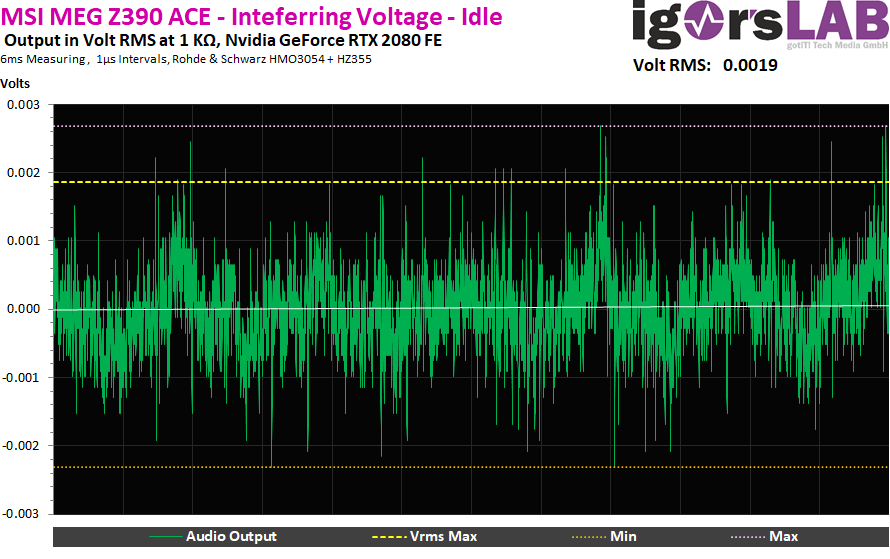
Next, I measured the scattering of the frequency salad secreted by the graphics card under load and the interferences that occurred, which is exactly what you can even hear as a mixed product. You know something like that, for example. as noise when scrolling or moving screen contents or as chirping in the audio branch during gaming. The level here rises to a good 5 mV, which is also acceptable or Seems. After the next measurements at the latest, this value, which in itself is quite good, is again somewhat relative.
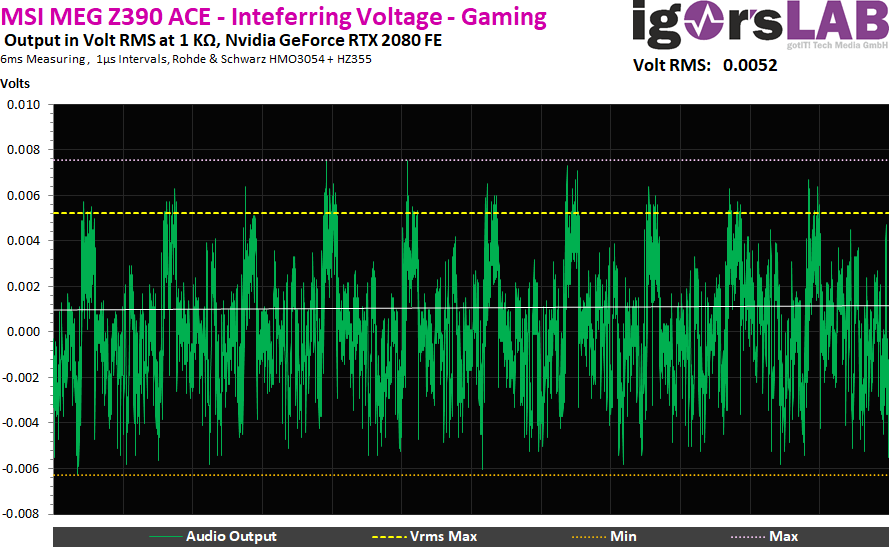
Achievable output power and voltages
At the latest now the ALC 1220 reaches its limits, because as good as the codecs may be, it does not offer a real headphone amplifier. The levels reached are more than sufficient to connect active boxes, but with headphones we are tight, very tight. The values measured below refer to one of the two stereo channels (left). I set the maximum level so that the distortion was less than 1%.
I start my measurement at 4 ohms and hit with the achieved 2 milliwatts RMS or 90 mV RMS at clear limits. Connecting small active boxes may still be just like this, but it definitely doesn’t get loud, it stays ultra-quiet.
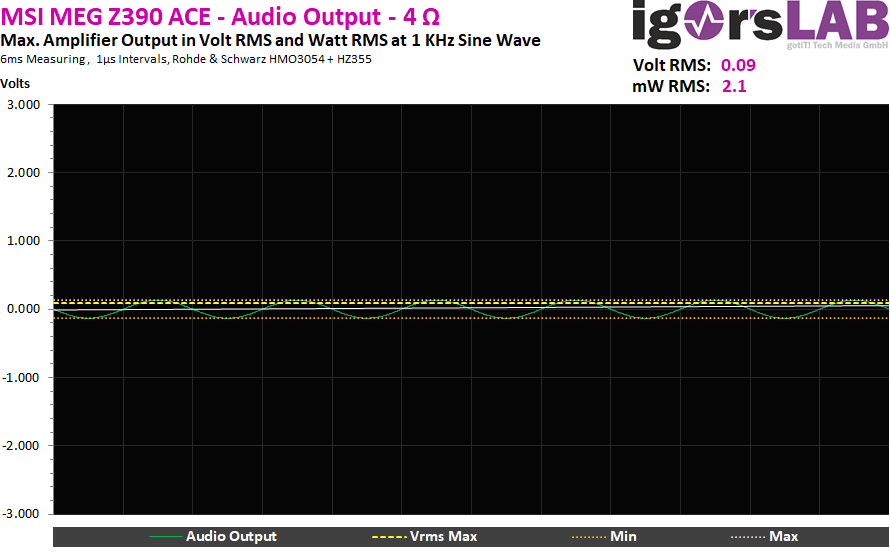
The output power increases slightly at 8 ohms and with approx. 170 mV I measure a little more output voltage here as well. Nevertheless, this is nothing to even usefully operate active systems. However, you almost always rely on active boxes on the desktop, so That I don’t see this too critically until now.
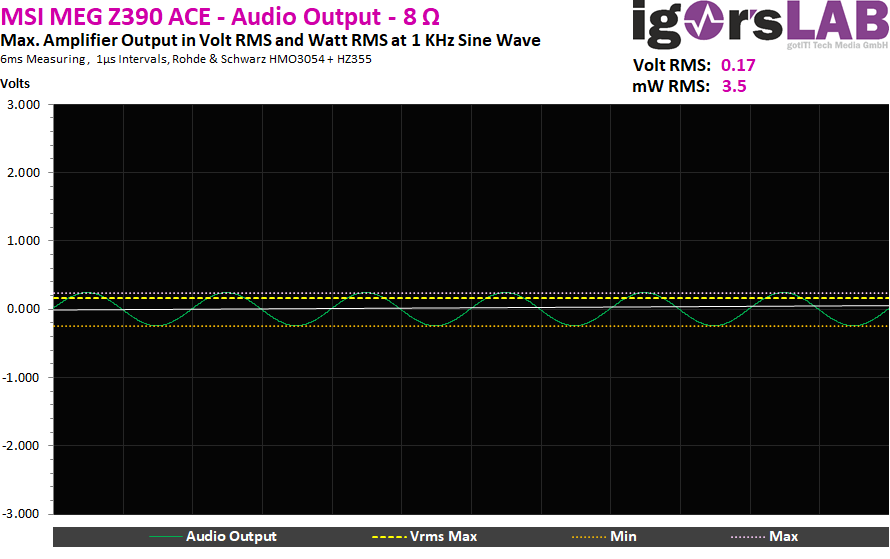
Worse is the rather meager output power of 7.5 milliwatts per channel at 32 ohms. Even with the not even 500 millivolt RMS, you don’t pull sausages off the plate. In the low-impestate area, the sound solution installed here is therefore a bitter disappointment. This is neither level-proof, nor somehow even a little noisy. Those who cannot rely on extremely sensitive headphones will therefore rightly be bitterly disappointed.
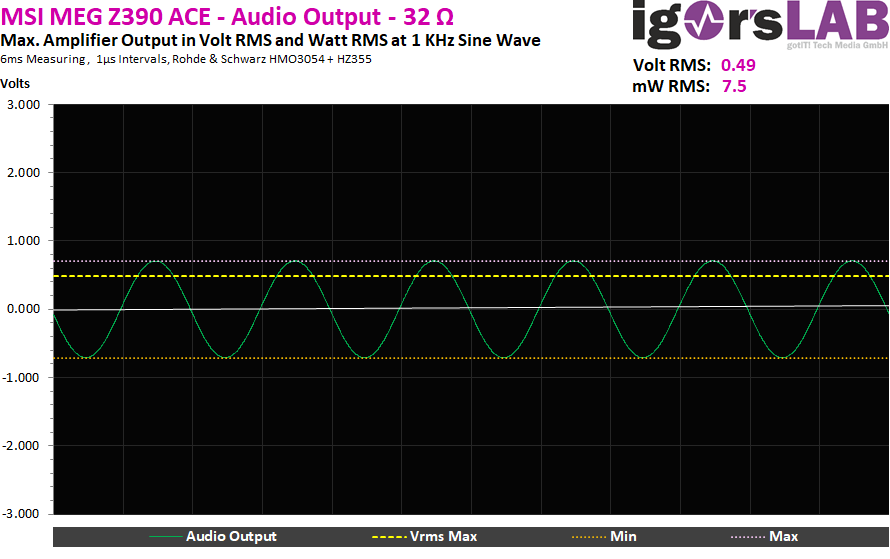
Paradoxically, the chip performs at 250 ohms about the same (or poor), so that 7.4 mW RMS are also attached here, which result from the increased output voltage of 1.36 volts RMS. This voltage probably corresponds exactly to what the ALC 1220 is able to achieve in this selected circuit. However, MSI could also have chosen higher reference voltages than 2 volts, because the ALC 1220 allows up to 3 volts instead of the 2 volts measured here (see amplitude). But you have to use it that way. But obviously you didn’t do that, for whatever reason and I just suspect a carelessness in creating the board design. However, one should actually know the possible connection.
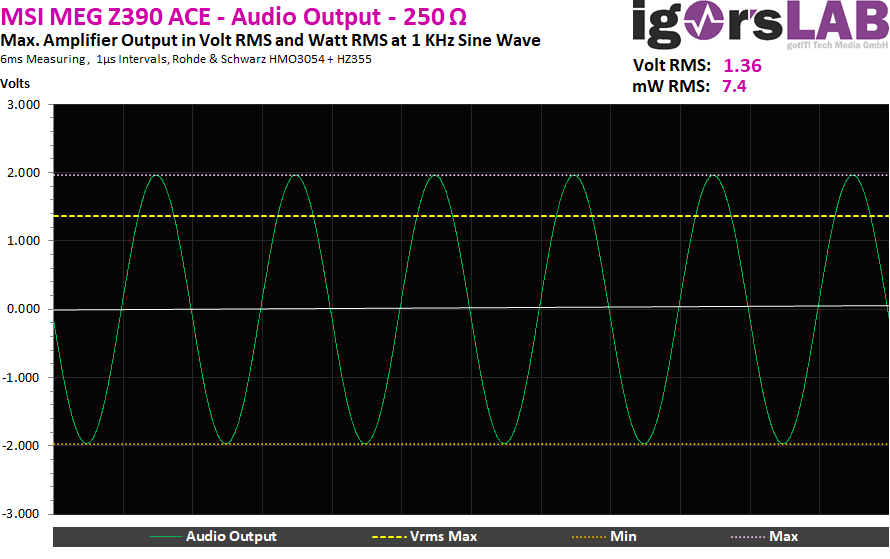
The whole thing then continues seamlessly even at 500 ohms (and higher), because more than 2 volts of peak voltage (1.36 volts RMS) simply do not work. The output power of a mischievous 3.7 mW RMS is the logical consequence for this.
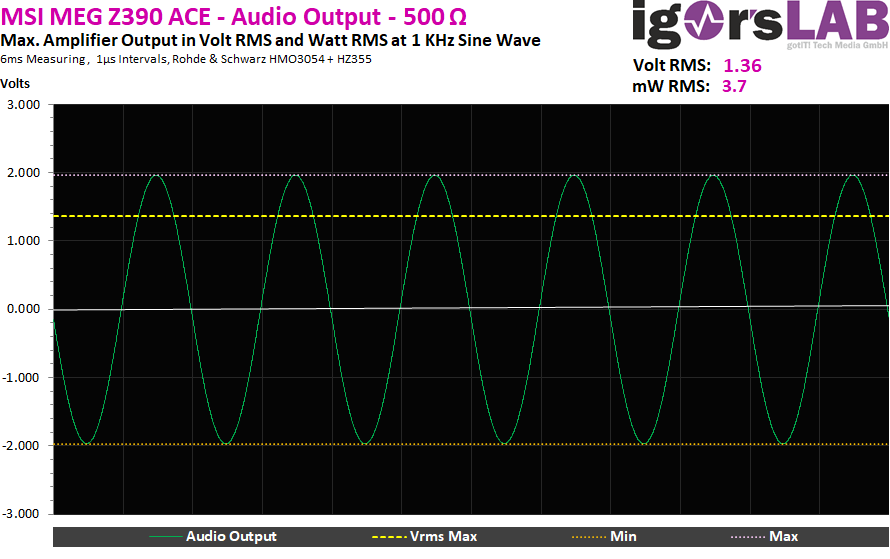
Calculation for output power and sound level
If you buy headphones, the so-called sensitivity is a very important indicator of how loud it can be operated in the end, i.e. which sound pressure level SPL (Sound Pressure Level) it can still reach cleanly at which amplifier power. But you don’t always produce a certain sound pressure in the same form. A lot depends on the recorded material. So if you have an average, well-tolerated level (SPL) of e.g. 85 dB (child-proof and not harmful in the long term), e.g. in classical music and its high dynamic range for the peak values, add 25 to 30 dB. This also applies to good games with 12 to 18 dB. Pop music, on the other hand, usually stands at “only” 8 to 12 dB surcharge as a formula of thumb
The first table shows us rather bad headphones with a sensitivity of 85 dB/mW up to 94 dB/mW and which amplifier power to set in order to reach maximum sound pressure levels between 90 and 115 dB. Whether the parts will endure and survive at all is, of course, another matter. If you know the impedance of your headphones, the above measurements also provide the output power in watt RMS, which you now have to look for on the left Y-axis of the curves. The X-axis shows the resulting sound pressure level SPL in dB and the colored curves can be assigned to the respective characteristic sensitivity of the respective headset.
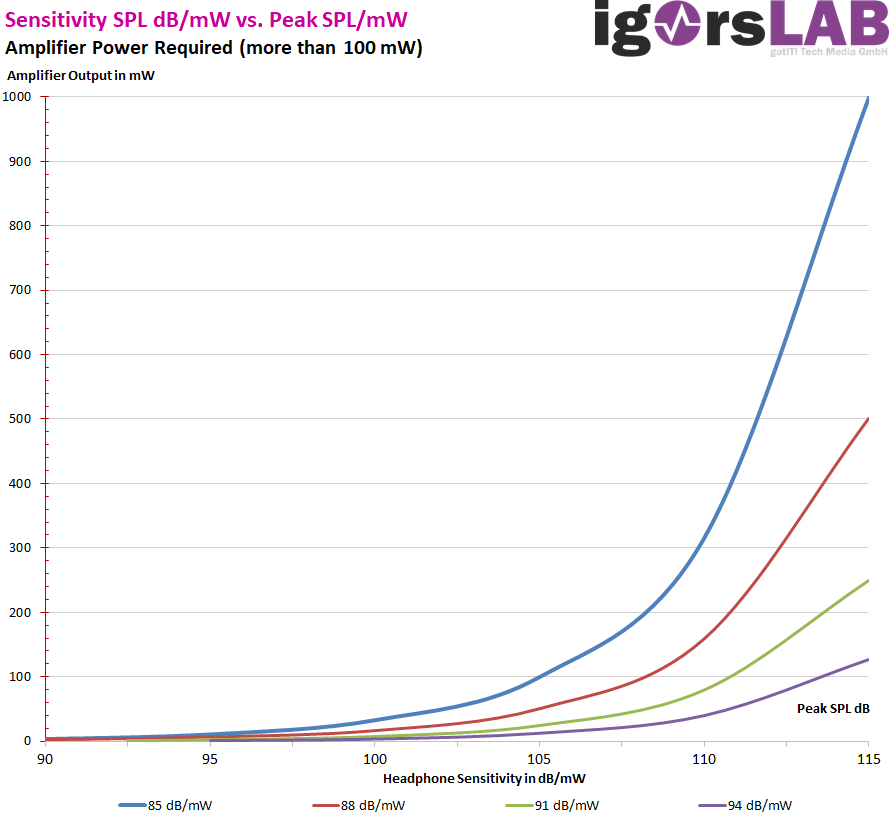
Here I would have the slightly better headphones, which are limited with the output power.
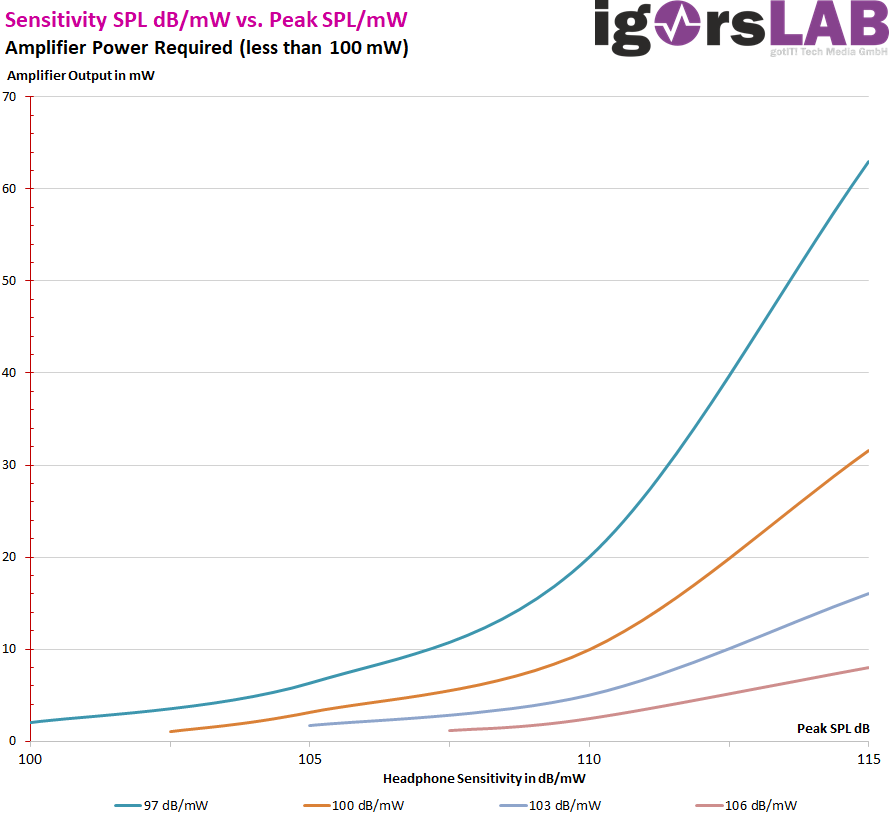
Intermediate conclusion
MSI would have been well advised to use a simple op-amp stage as a afterburner here as a “booster”, because such a thing is already available for a few cents, even if it of course eats up further space on the board. Instead, you prefer to advertise with Japanese capacitors… Dear Lord God, please leave it a little more brain or. Operational amplifiers rain, because what are the use of the most beautiful caps when the level for the acoustic filtering out of such marketing savvy is far too low? It’s like a set of Z tires on a 69 hp Fiat Panda. Beautiful to look at, but completely superfluous.
If you have low- or medium-sensitivity headphones that require higher amplifier performance, this solution is definitely not enough, you have to be aware of that. For my part, I don’t even get my really high-quality Amiron Home from Beyerdynamic with its 250 ohms nearly controlled. Here, as a customer, you will really have to make a case decision and, if necessary, you will have to orientate yourself on the existing or planned technology.
The effect of the transients, i.e. the foreign scattering of the graphics card under load, is present, but sufficiently small. This is laudable and also shows a more functional board layout. The measured 5.2 mV at 1 KOhm are acceptable, although still present and detectable. However, other motherboards with significantly higher gain can do this even better.

















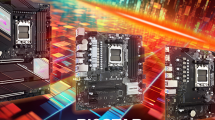
















Kommentieren